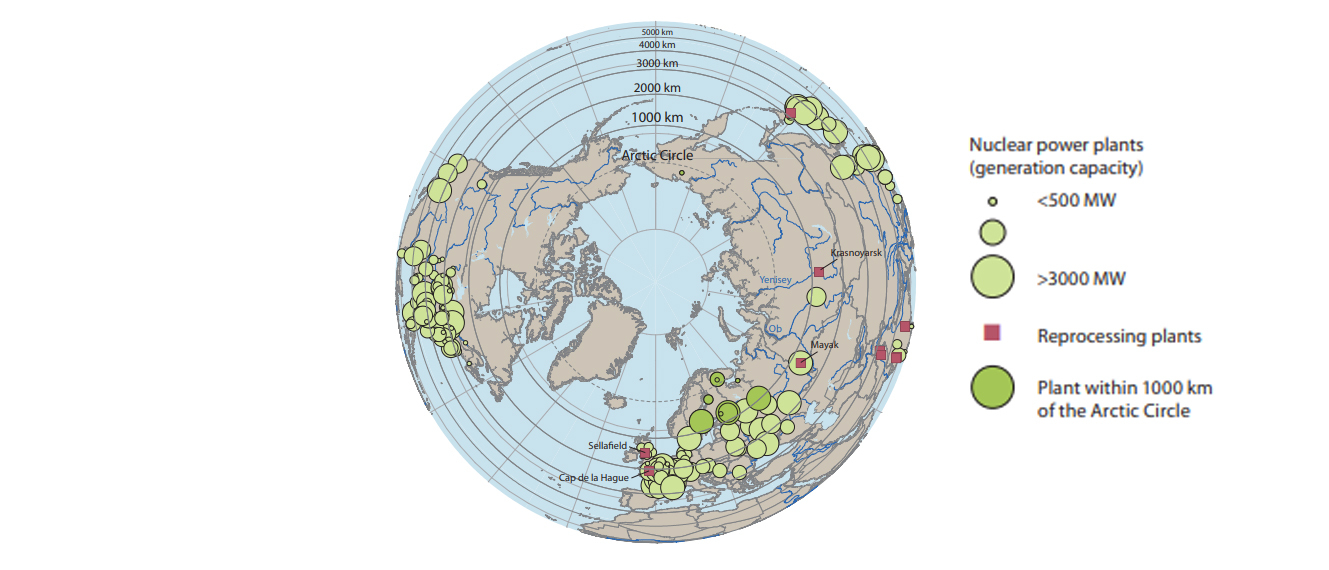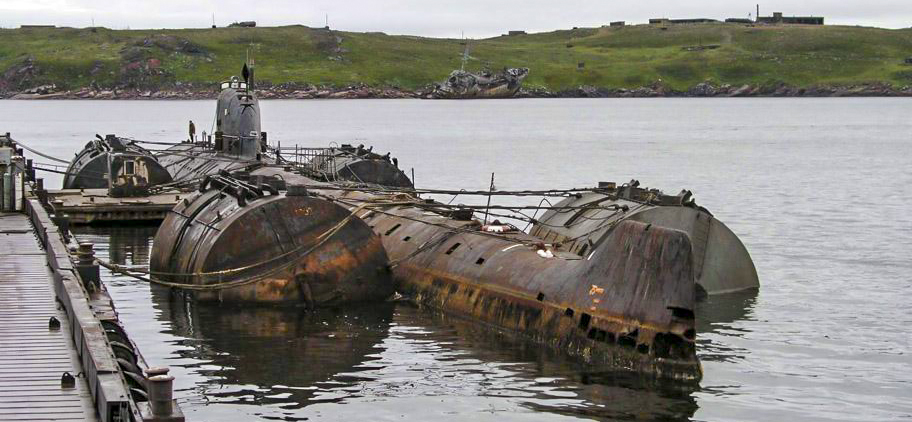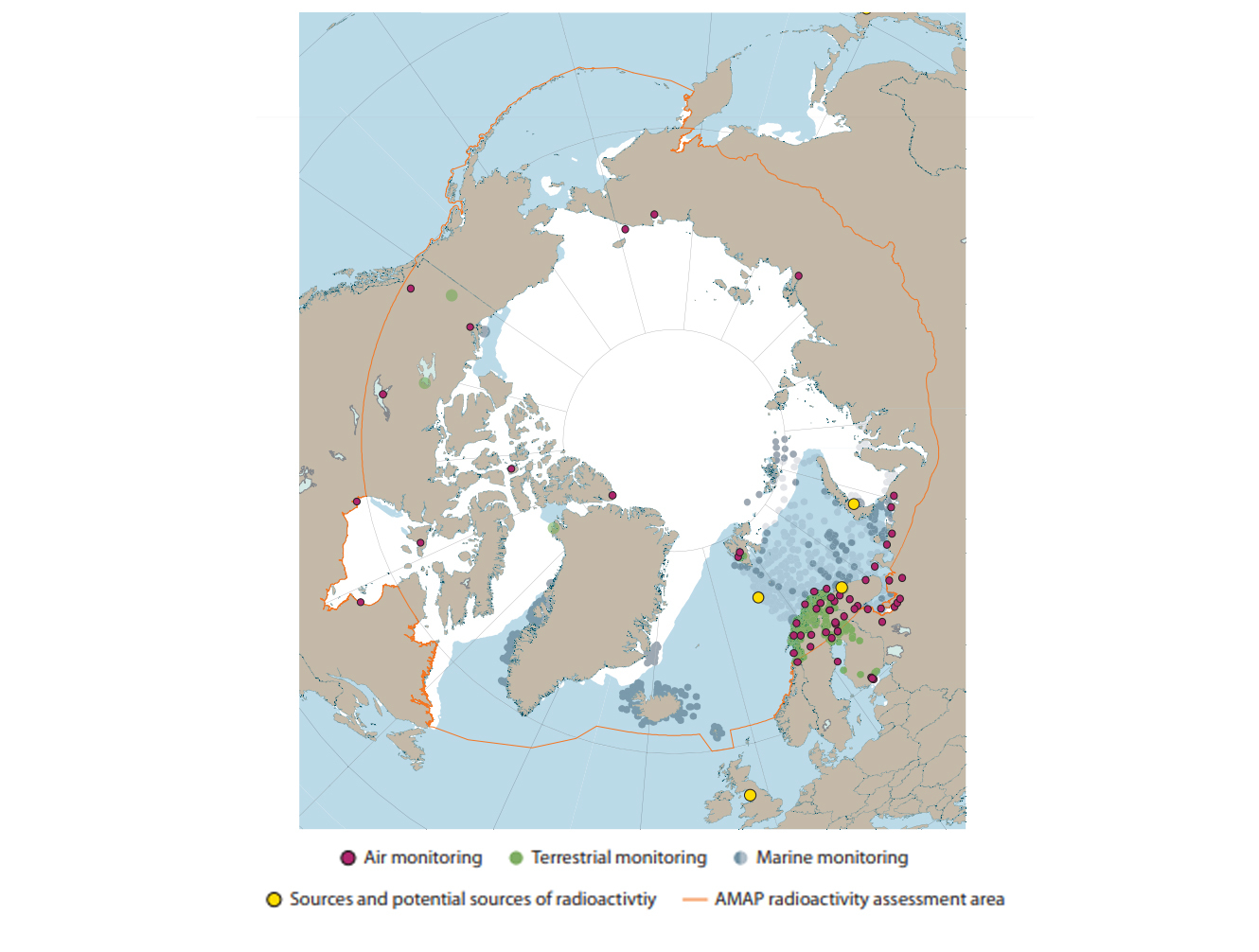WHAT ARE THE SOURCES OF RADIOACTIVE CONTAMINATION IN THE ARCTIC?

Figure 1: Proximity of nuclear power plants and reprocessing facilities to the Arctic. Source: AMAP Assessment 2015: Radioactivity in the Arctic. Source of data: www.iaea.org/pris and Davis et al. (2015).
Monitoring the levels of radioactivity within the Arctic environment is a central part of the AMAP program. High levels of naturally-occurring and man-made sources of radionuclides found in the Arctic remain of interest.
- Anthropogenic radionuclide sources
The Arctic is vulnerable to radioactive pollution transported from distant sources, whether by ocean currents or via the atmosphere. The main source of radionuclides in the Arctic is inherited from open-air nuclear tests run mostly in the northern hemisphere from 1945 to 1995. The deposition of radionuclides occurred in all Arctic regions above 60°N, with the highest numbers found in Iceland, Norway and Sweden. Past accidents near Tule Air Base in Greenland, aboard the nuclear submarine Komsomolets in the Norwegian Sea, in Chernobyl and Fukushima released radioactive material. Radioactive liquid discharges from nuclear installations in France and Britain to the North-East Atlantic are transported by currents through the North Sea and into Arctic Areas. Finally, nuclear sites within or beyond the Arctic circle have the potential to contaminate Arctic areas.
New sources of radioactive contamination include the decommissioning of nuclear power plants in Europe, and the construction of new nuclear power plants where a nuclear accident could potentially affect the Arctic region.
Today, concentrations of anthropogenic radionuclides in the Arctic are very low, and generally declining. Still, potential releases from local sources as K-159, Komsomolets and dumped nuclear waste may increase local contamination levels. Additionally, some other sources – even located far from the Arctic - have the potential to increase local contamination levels. This underlines the importance of environmental monitoring in the Arctic region.
- Naturally occurring radionuclides
Life on earth evolved and currently exists in a naturally radioactive environment resulting from the exposure to radionuclides of both cosmic and terrestrial origin. Concentrations of naturally occurring radionuclides and levels of natural background radiation vary geographically across the Arctic, primarily influenced by altitude (cosmic) and surrounding geology (terrestrial). Naturally occurring radionuclides (NORs) of terrestrial origin are present in various degrees in all environmental media, including the human body. The major sources of terrestrial NORs are radioactive potassium and thorium, uranium, and their associated progeny. While relatively common in the earth’s crust, including the Arctic, they are less commonly found in commercially viable ore deposits. However, potentially viable uranium deposits have been identified in a few locations, including the Canadian Arctic and Greenland.
Due to the ubiquitous nature of NORs, these can be concentrated and environmentally mobilized by several resource extraction activities, including the mining and processing of not only uranium but other metals, rare earth elements, coal, phosphates, geothermal energy production, and oil and gas extraction. The combustion of coal and peat also atmospherically mobilize associated NORs. Released from industries, NORs can also be long-range transported to the Arctic via the atmosphere and ocean currents.
As a range of human activities such as the oil and gas industry can concentrate and environmentally mobilize NORs, it is important to characterize current sources, environmental behaviours and exposures to support not only the science but the public‘s understanding of NORs and radiation in general. This is especially important in the Arctic due to the significance of traditional foods to the economic, health, and cultural well-being of arctic communities. Misunderstandings and misconceptions with respect to radionuclides in traditional foods can result in the avoidance of such foods even when their radionuclide content (from a NORs perspective) may be completely natural, safe and at levels that have been consumed for generations.
A comprehensive understanding of the science associated with NORs sources, concentrations and behaviour into the environment, and radiation biology is necessary for risk informed decision making on the future of the Arctic. Environmental impact or risk assessments balancing benefits and potential impacts associated with hazardous substances and radionuclides before starting any industrial activities that could lead to contamination of the Arctic environment is therefore crucial.

Figure 2: K-159 nuclear powered submarine. Source: Bellona.
MONITORING RADIOACTIVITY IN THE ARCTIC
AMAP is mandated to monitor and assess the status of the Arctic region with respect to pollution and climate change issues. This work helps inform the transport and distribution in time and space of radionuclides in the environment, and as well as understanding the long-term impacts of contaminants on ecosystems, food webs, and human health over time.
For example, 12-years monitoring results of Yellowknife station indicated that activity concentration ratio of 210Pb to 212Pb, presents a clear seasonal distribution. It has a relatively low constant value in summer, and a significant peak symmetrically distributed around February in winter. The peak period is the long-range transport time of aerosol to the Arctic. Therefore, it can be used to assess the transport of pollutants to the Arctic, such as the Arctic haze from Eurasia. The study shows that the season of Yellowknife’s continental-influenced air mass usually starts in mid-to-late November and ends in mid-to-late April. The period of the Arctic affected by the long-distance transportation of aerosols generally varies between 67 and 88 days each year.
Although several of the sources of potential radioactive contamination in the Arctic have been reduced in the past decades, there is still a clear need for scientific monitoring of radioactivity: future accidents can take place unexpectedly, climate change has the potential to remobilize radioactivity, and finally, large amounts of radioactive waste were dumped at sea and could eventually start to leak out. Several studies have shown the usefulness of radionuclides as a method to monitor slowly evolving environmental processes and changes and this, in turn, calls for sustained radioactivity monitoring in the Arctic region.

Figure 3: Monitoring results and sources and potential sources of radioactivity discusses in AMAP 2015 Assessment. Source: AMAP Assessment 2015: Radioactivity in the Arctic.
Atmospheric and marine monitoring stations (see Fig. 3) will continue to provide a means for detecting routine or accidental emissions from nuclear facilities and help provide early warning of major nuclear events. This crucial monitoring mission is tied to continued cooperation between Arctic nations.
HOW IS CLIMATE CHANGE IMPACTING RADIOACTIVITY IN THE ARCTIC?

Figure 4: Thawing permafrost in Northern Siberia. Source: NASA Earth Observatory.
The Arctic is currently the fastest-warming region on Earth. Climate change could potentially remobilize radionuclides already present in the Arctic environment. Decreasing snow cover and thawing permafrost could lead to an increase in the release of radon gas and its decay products, exposing Arctic residents to higher levels of radiation.
The warmer the Arctic gets, the more accessible it becomes. The development of extractive industries (oil, gas, uranium) is likely to increase in coming years, and will inevitably lead to increased pollution in the region.
